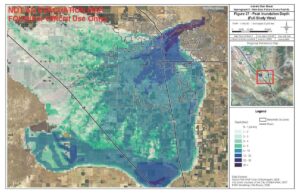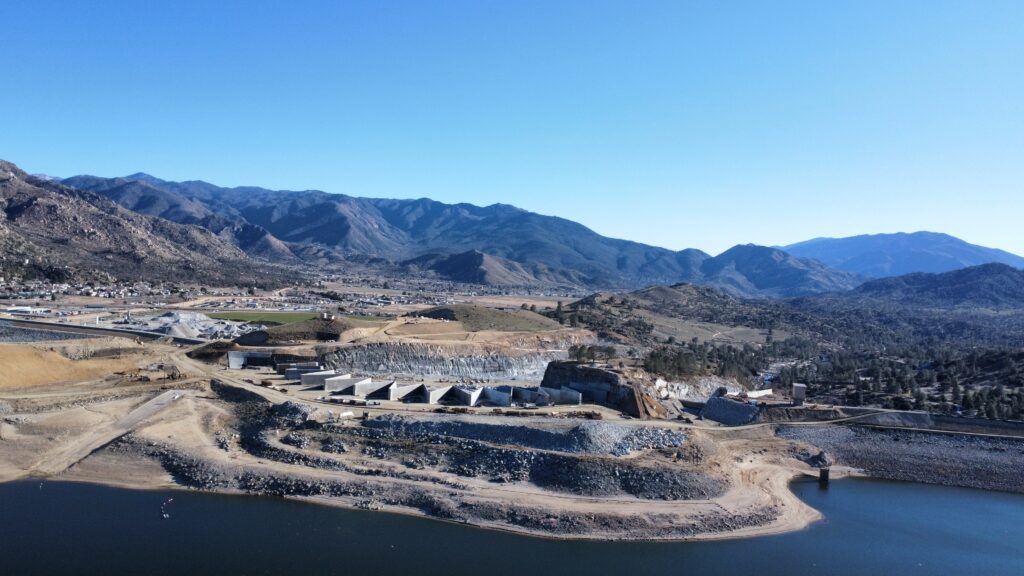The U.S. Army Corps of Engineers officially lowered the risk level of Isabella Dam from “highest urgency and risk” to “low urgency” on Thursday.
Though an Army Corps spokesman said this means Isabella has returned to “normal operations,” it’s unclear what exactly that will mean for downstream Kern River irrigators as we grind through summer and approach a new water year.
The Army Corps would still like the lake to hit its maximum capacity of 568,000 acre feet, according to Kern River Watermaster Mark Mulkay. As of Thursday afternoon, the lake stood at 543,255 acre feet.
“We’re kind of in a weird situation where we’re trying to get the reservoir as full as possible now, but have to turn right back around and take a bunch of water out,” Mulkay said.
That’s because, under the existing Water Control Manual, Isabella has to be drawn down to 170,000 acre feet by November 1, to make room for anticipated precipitation over the winter months.
Kern River irrigators have unofficially asked to boost that “carry over” amount. In the past, the Army Corps has granted waivers allowing up to 245,000 acre feet to be kept in the lake during dry years. Kern River interests would like to see a larger carry over amount codified in the new Water Control Manual
The Isabella Water Control Manual will be rewritten to reflect the new Isabella Dam construction, according to an Army Corps spokesmen.
Kern River interests are hoping to participate in that process, particularly after this past year when they demonstrated they were able to gobble up historic amounts of runoff into recharge basins that didn’t exist when the previous manual was written.
“Yeah, we’re giving them all our reasons,” Mulkay said. “They do have some flexibility and we think they’ll work with us.”
But, he said, rewriting the manual likely won’t get underway until sometime next year.
“Right now, though, the main restriction of keeping the lake at 360,000 acre feet is gone. It’s gone. And that’s a good thing,” Mulkay said.
Back in 2005, Isabella was given a Dam Safety Action Classification (DSAC) rating of 1, the most at-risk rating for all dams under the Army Corps’ purview.
It was discovered that the earthen portion of the dam was highly vulnerable to seepage that could cause internal erosion and ultimate failure. During the seepage investigation, Army Corps geologists also discovered an active fault directly alongside the dam. It was also determined the dam was in danger of overtopping during a big enough water year.
In its Environmental Impact Report outlining its planned fixes, the Army Corps noted that the dam “would be almost certain to fail under normal operations in the near-term without intervention.”

The Army Corps ordered the lake drawn down to 360,000 acre feet in 2006 and that remained its maximum fill line for 16 years.
Construction on the fixes – a new labyrinth weir and emergency spillway, raising the main and auxiliary dams by 16 feet and improvements to the dam’s filtering and drainage systems –was completed in October 2022 just in time for one of the most epic winters in California history.
“This is the culmination of more than 15 years of effort to reduce the risk to downstream communities against catastrophic flooding from a potential dam breach and return the project to normal operation,” Mike Ruthford, lead engineer for the Isabella Dam Safety Modification Project is quoted in an Army Corps press release. “This is incredibly exciting for this team and this district.”
Isabella’s DSAC rating was officially downgraded to level 4, “signifying a low risk,” according to the Army Corps press release. The Army Corps will continue monitoring the dam’s performance over the next few months, the release states.
“We’ve achieved our project safety goal,” Ruthford is quoted in the release. “With this year’s snowmelt, we are able to see how the dam performs in the first year after the new improvements were finished.”
Share this:
- Click to share on Facebook (Opens in new window)
- Click to share on Twitter (Opens in new window)
- Click to share on LinkedIn (Opens in new window)
- Click to share on Reddit (Opens in new window)
- Click to share on Tumblr (Opens in new window)
- Click to share on Pinterest (Opens in new window)
- Click to share on Pocket (Opens in new window)
- Click to share on Telegram (Opens in new window)
- Click to share on WhatsApp (Opens in new window)
- Click to print (Opens in new window)








You must be logged in to post a comment.